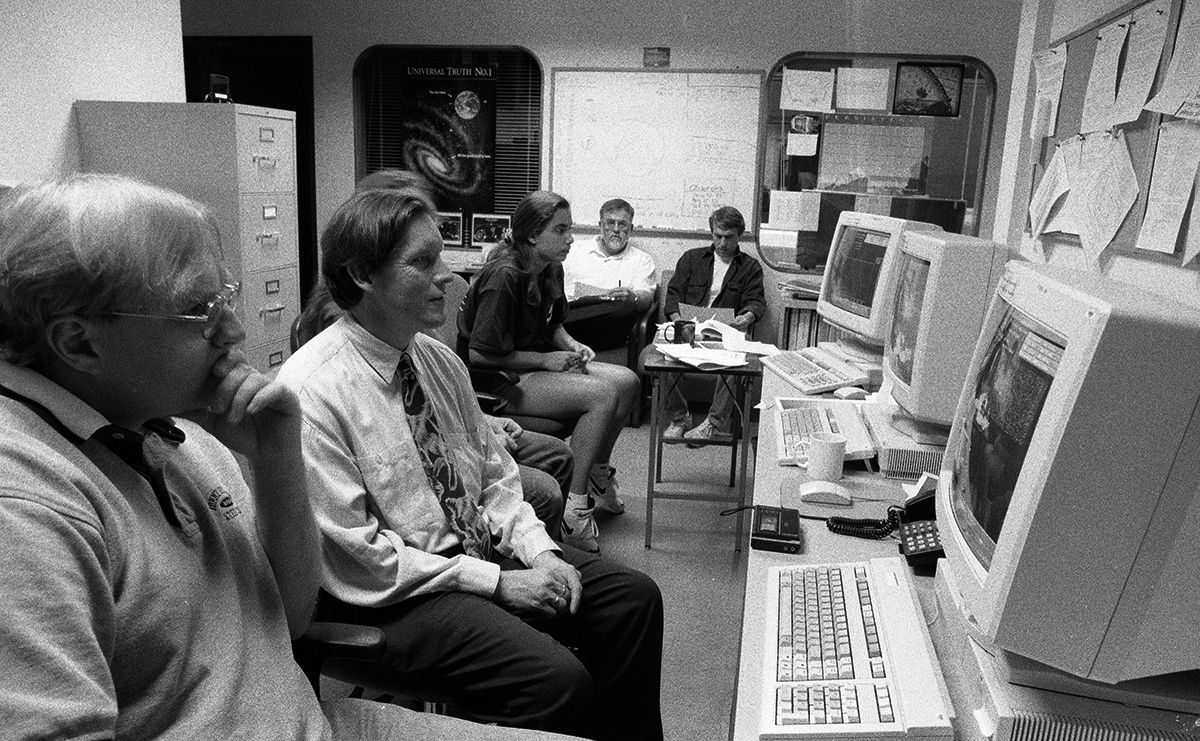
Scientists at the SETI Institute monitor an intriguing signal in 1997. While this transmission was first thought to be extraterrestrial, it was soon traced to telemetry from the SOHO solar research satellite. Credit: S. Shostak
So far, scientists have found no convincing evidence for biology beyond our home planet. Nonetheless, SETI researchers are confident that it’s just a matter of time until we discover a signal proving that intelligence exists elsewhere.
Imagine that next week or next year we detect a ping from the cosmos. What happens?
First, let’s dispense with some conspiratorial ideas. There are people who believe that if proof of aliens were found, the news would be buried – probably at the instigation of the federal government. But the SETI Institute is not a branch of the government – it’s a non-profit entity, organized under the aegis of the state of California.. In addition, rest assured that the first thing anyone would do upon detecting a tantalizing signal is to contact people at other observatories to request help in confirming the discovery. Lots of people would know. Secrecy is neither a possibility nor a policy.
In addition, there’s also the perplexing matter of why anyone would want to keep this discovery secret? The easy answer – offered by many – is that the public would flip out. But ask yourself: Would news of a confirmed signal coming from umpteen light-years away cause you to run screaming into the street? Would your cerebral equilibrium be so disturbed that you just couldn’t handle the news?
Not likely.
In fact, the world ran a relevant experiment on the public’s reaction two dozen years ago. In 1996, the blockbuster science news was a claim that fossilized microbes had been found in a meteorite – a hunk of Martian regolith kicked off that planet many thousands of years ago. The meteorite — known as ALH 84001 — was a small sample of Mars that seemingly contained the miniscule corpses of microbes that swam the planet’s seas billions of years ago.
This was a huge story, but the public’s reaction was as calm as the dawn. Folks just wanted to know more.
A second relevant fact is that about one-third of the populace believes that Earth is being visited by aliens today, strafing the stratosphere in their saucers. Those folks aren’t distraught. They still go to work in the morning.
No panic in either case. So, belief in secrecy following a SETI detection is misplaced. But is there any formal plan for what to do should a signal be received? In the 1980s, during the time of the NASA SETI program, John Billingham – the British physician who started that program – was interested in the social consequences of finding E.T. He organized informal and formal discussions about the societal implications of the search (the proceedings of the workshop held in 1992 has been published.) He also felt that, given the unsettling paranoia and competition of the Cold War, a protocol should be established laying out the steps to be taken if a compelling signal were found.
In 1989, a document was produced with the title “A Declaration of Principles Concerning the Conduct of the Search for Extraterrestrial Intelligence.” One of the principal motivations for this document was to ensure that neither side in the Cold War would try to monopolize information about any possible SETI detection. The Declaration had no force of law, and not all groups doing SETI experiments signed on to it. The United Nations also expressed little interest. Nonetheless, it became a de facto guide to what actions should be taken after a signal was found.
However, the original Declaration was nebulous and self-contradictory. Consequently, a subcommittee of the International Academy of Astronautics (IAA) produced a shorter and cleaner version in 2010: Declaration of Principles Concerning the Conduct of the Search for Extraterrestrial Intelligence.
Like its predecessor, its stipulations are few, to wit: In case of a compelling signal detection, (1) verify that it’s truly an extraterrestrial source; (2) announce its discovery to the world; and (3) do not transmit any reply without first seeking international consultation.
Experience with false alarms and deliberate signal hoaxes has shown that the immediate aftermath of picking up a transmission could not be handled in the simple manner proscribed in the Declaration. Consider what occurred in 1997, when a signal was detected that, for about a day, seemed to be both genuine and extraterrestrial. Because there is no policy of secrecy, this detection quickly became known outside the research community. Within 15 hours, the New York Times placed a call to the Institute, asking about the story. Note that this showed that the orderly progression of events assumed by the Declaration is unrealistic. There will be a period (days to weeks) during which SETI researchers and others will scramble to confirm the signal, and in all that time the media will be running stories.
In anticipation of this chaotic situation, the IAA’s SETI Permanent Committee formed a subcommittee to deal with post-detection scenarios. This group thought it desirable to construct an internet page on which legitimate SETI groups could post information about any intriguing signals. The page would be useful both for other SETI groups and for the media. It would serve as an uncorruptible authority for any discovered signal. Lamentably, this idea has not been implemented.
The above gives some idea of the thinking about the immediate reaction to a detection. However, the long-term social implications of establishing the existence of extraterrestrial intelligence are hard to gauge. Of course, such a discovery would immediately demonstrate that life is a process that begins on many worlds, and that evolution to intelligence has a non-zero probability – ideas that, as of now, are no more than an appealing hypothesis.
- Seth Shostak
